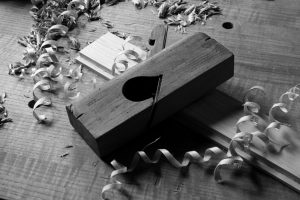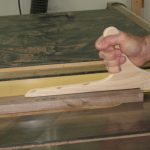We may receive a commission when you use our affiliate links. However, this does not impact our recommendations.
Even if I have an entire shop filled with power equipment, I like to cut my rabbets by hand. Why? It’s fast and fun.
Once you master a rabbet plane or a moving fillister plane, your router table and table saw will get a lot less use. To push you along this path, I wrote an article for the June 2012 issue of Popular Woodworking Magazine. The article explains how to sharpen, set up and use rabbet and plow planes and includes tips on how to get square joints the first time. (Hint: You are holding the tool wrong.)
To show how fast and fun these tools are I shot the following short video of me making a panel for a Campaign-style bookcase I’m building. The panel required rabbets that were parallel to and across the grain, so you’ll get to see how to attack both.
In the video I’m using the Veritas Skew-Rabbet plane, the best commercial rabbet plane made today – in my opinion. For a free article on how to use this tool to tighten your dovetails, click here.
— Christopher Schwarz
Editor’s note: For more – lots more – from Chris on all things handplanes, read “Handplane Essentials.“
Here are some supplies and tools we find essential in our everyday work around the shop. We may receive a commission from sales referred by our links; however, we have carefully selected these products for their usefulness and quality.










What hand tool(s) would you recommend using to cut a rabbet along a curved edge? Or is this the time to break out the electric router and rabbeting bit?
Monte
That was awesome!
Hold on a minute!
How come no demonstration of the woodie skew wabbit in the picture?
They do make prettier shavings you know. And they smell nice.
Carl
Chris,
Do you have only the right hand skew plane or the left as well? Matt Vanderlist mentioned having the left could be useful where grain would cause tear out. Perhaps your use of the shoulder plane provides an alternate which saves money and that’s why you did it?
Jay
great demonstration! especially on how to first score by backing the plane then doing the rabbeting. great music too. I wonder who it was?
One area of frustration I’ve long had with metal rabbeting planes, and this includes the Veritas, is that the settings creep on me; mostly the depth stop but sometimes the fence too. It is certainly possible I am just ham-handed, but I find the older wooden moving fillisters keep their settings much better, even though adjusting the fence is way more of a pain.
Christopher,
I see that you’re still working on campaign furniture; now a book case? Are you making a suite of campaign furniture, is there more in the works?
I enjoy building 18th century campaign furniture (using hand tools): a walnut folding field bedstead, two walnut folding side chairs, a painted oak folding cot, rectangular and a round leather covered campaign trunks, and am presently finishing up a mahogany folding table. A few photos of these and related project are at
http://galootcentral.com/index.php?option=com_copperminevis&Itemid=2&place=gallery&cat=10164
Cheers,
John
Chris,
What’s the difference between a rabbet and fillister plane?
Thanks for that timely video Chris, My new Veritas skew rebate plane arrived some time ago and I got round to using it for the first time today making a mini travelling chest on the lines of the ATC. I now know why you hold it the way you do when scoring across the grain. I also know why you think it is the best avialable and completly agree. It is so much better than my Grandfathers old wooden moving fillister that I have retired that 100 year old plane to the display cabinet. I shall also sell my Record #778.
Thanks for that – very useful.
Moronically I hadn’t thought to put the plank flush with the edge of my bench and use the extra registration surface.
Um, where’s the 10* or so test cuts I’d need to make on the table saw to get this just right?
(* exaggeration…mostly, but still, it’s a time saver to not have to do those, not to mention the safety factor)
Very nice tool, and great demo.
The shallow rabbet that you mention in your 2009 article assumes that you are going to cut tails first. Glen taught us to cut pins first in a class I took with him, and I switched. Can this shallow rabbet method be applicable to a pins first method? It does seem to be a good way to go. Jameel also used it for his condor tail last August, if I remember correctly.
Hey Chris,
you cut the rabbets in both grain directions with the same skew plane rather than using the left and right. Do you only have the one, or do you have both but find that switching for grain direction is unnecessary?
curious
pete
Perfection!